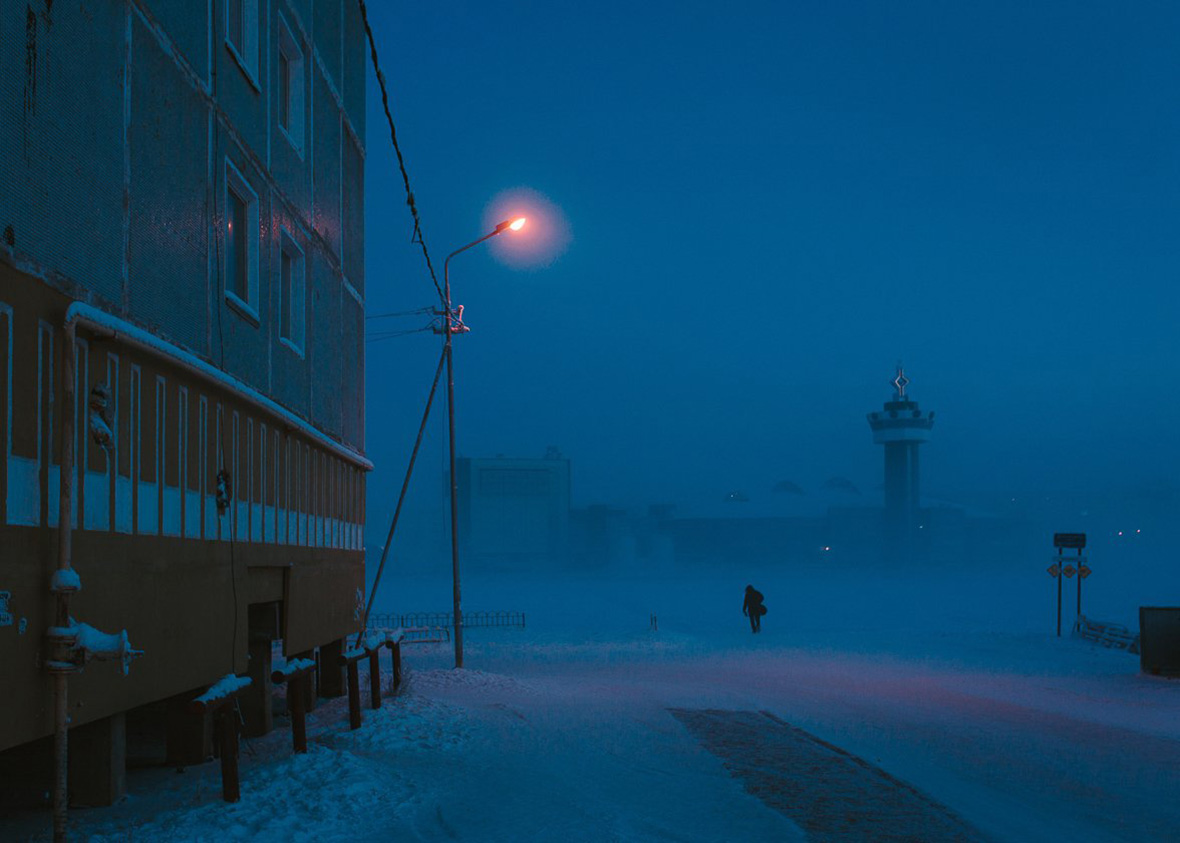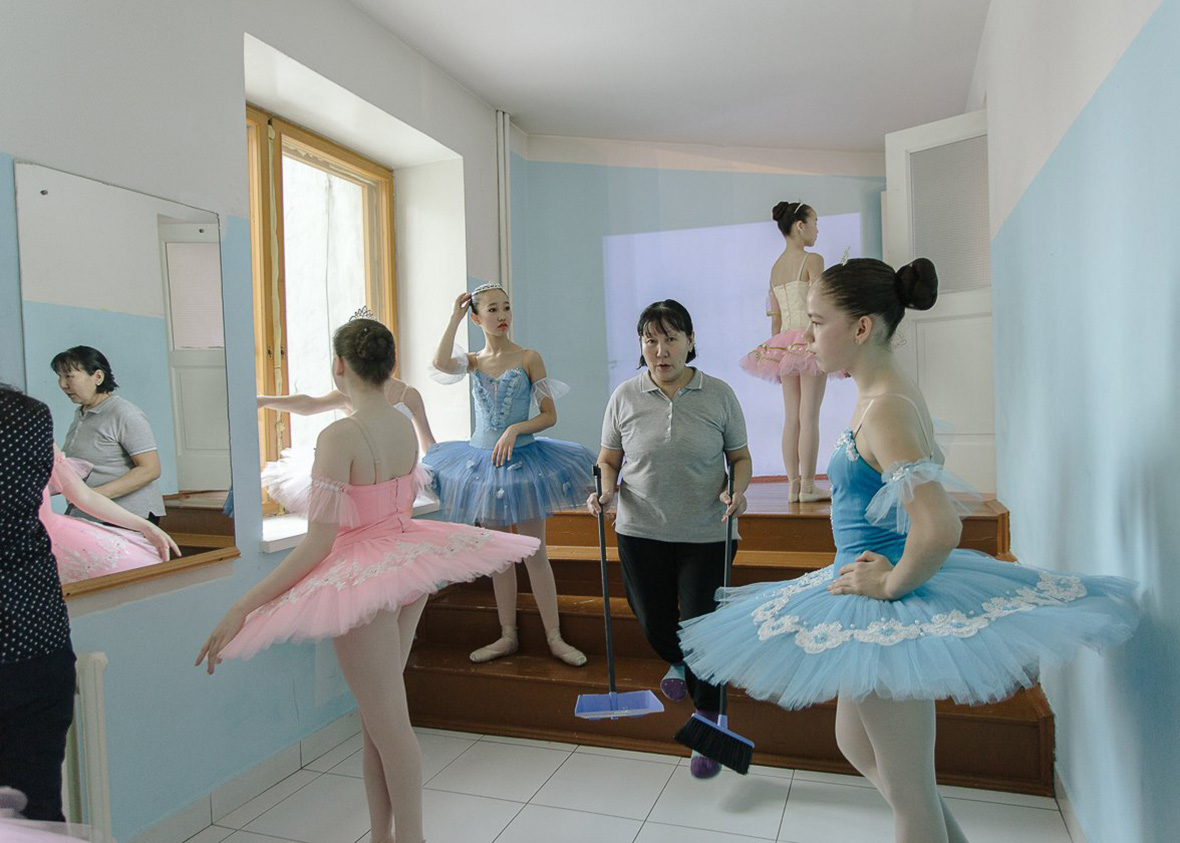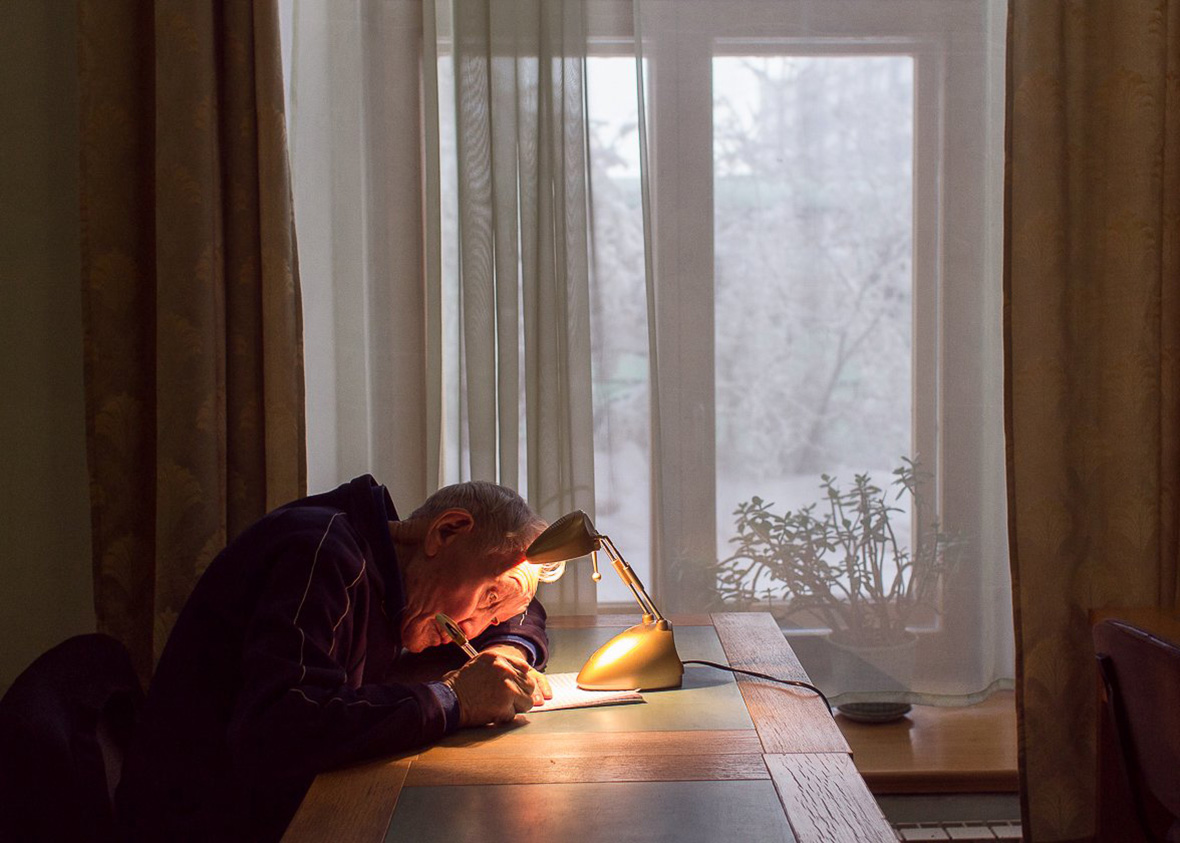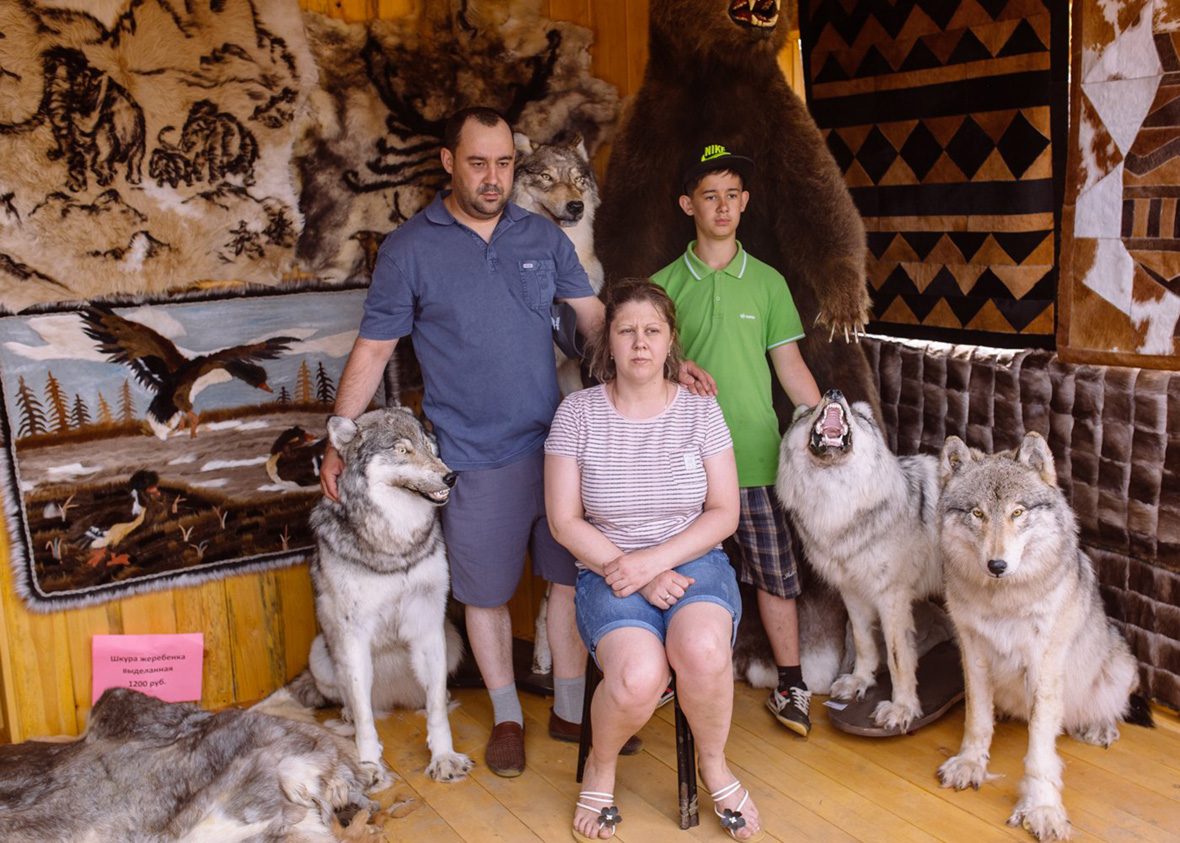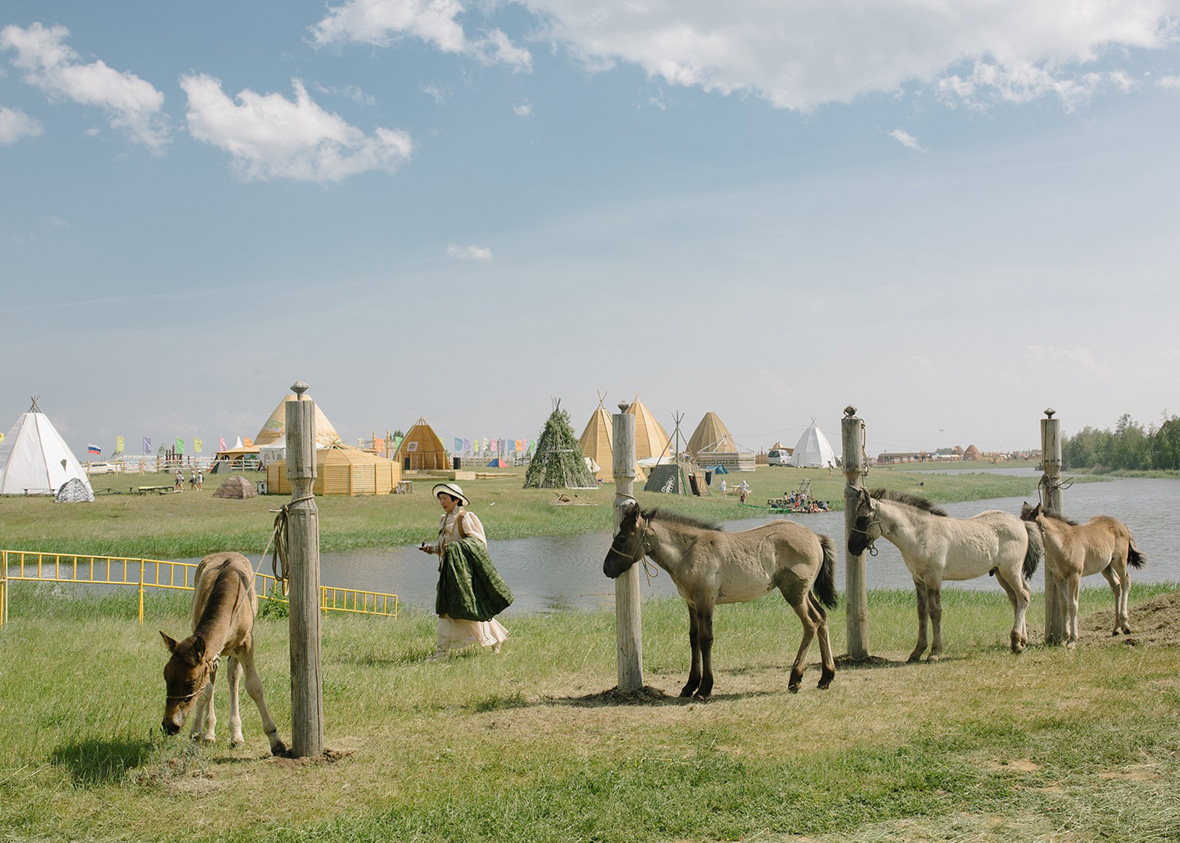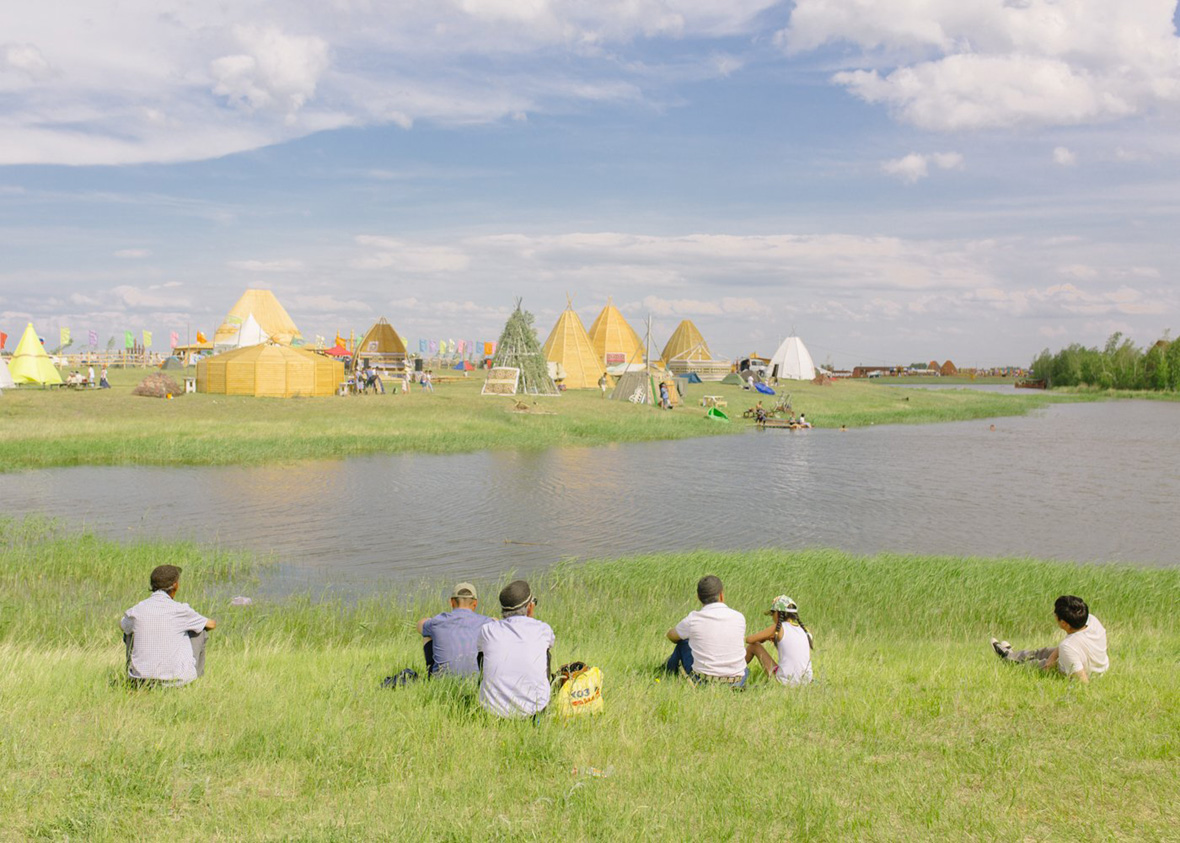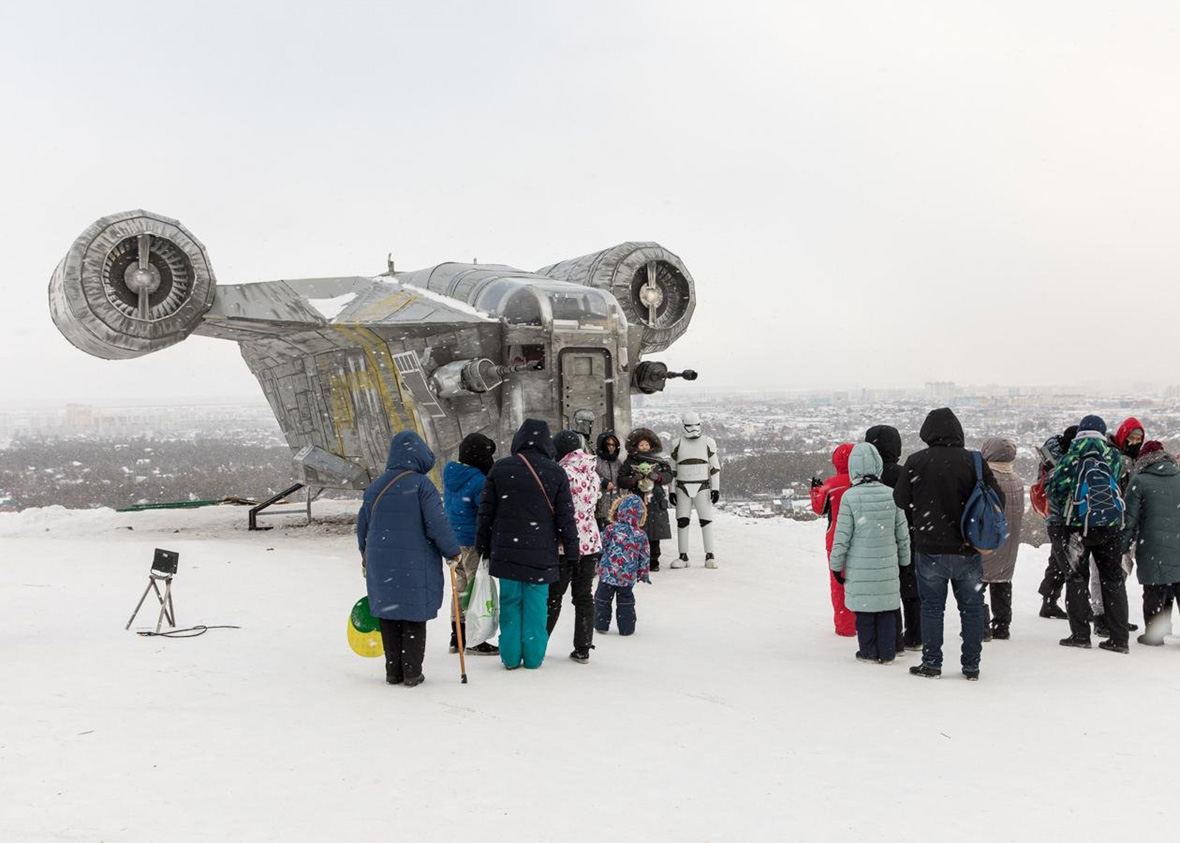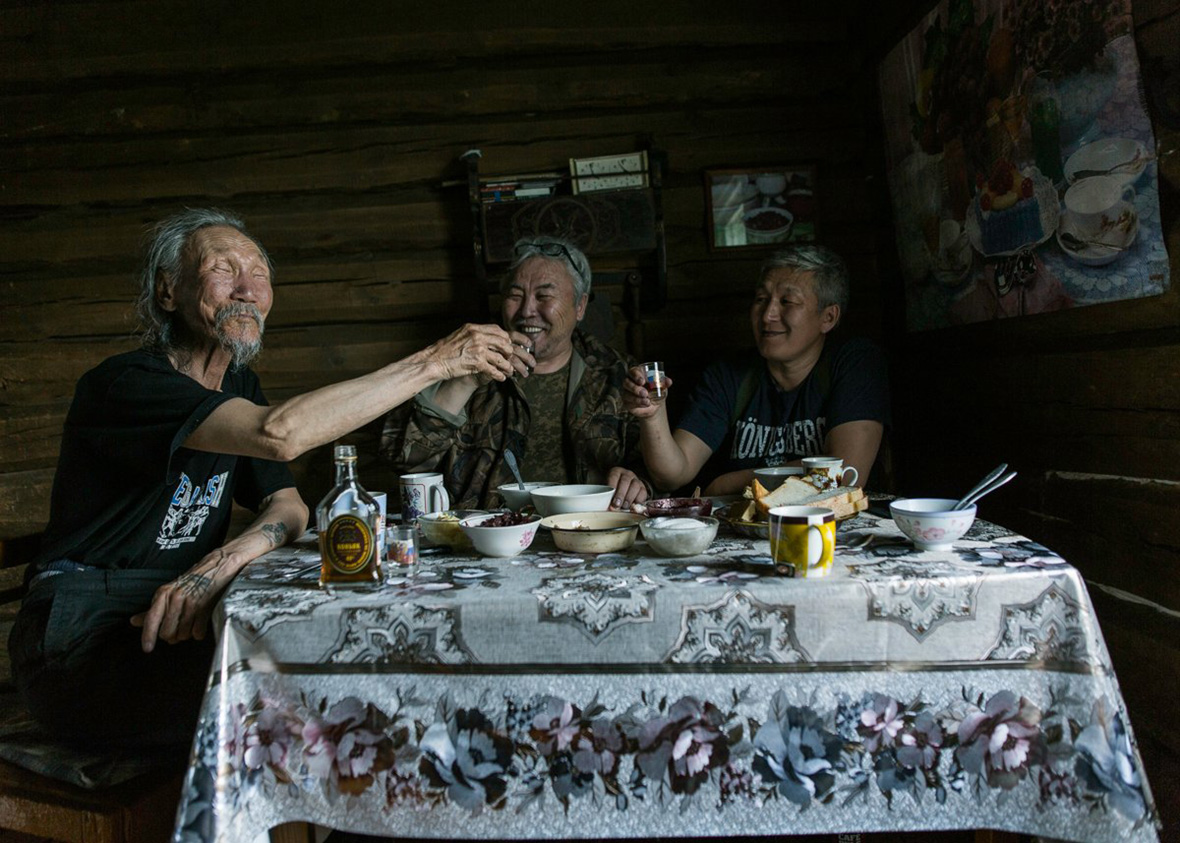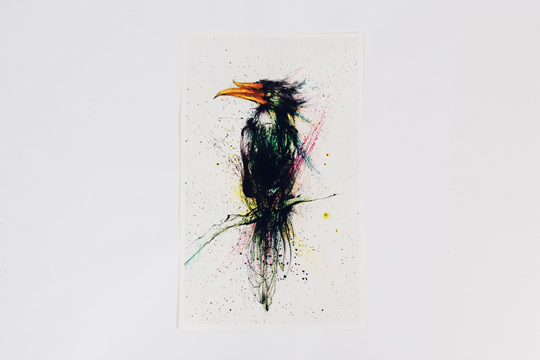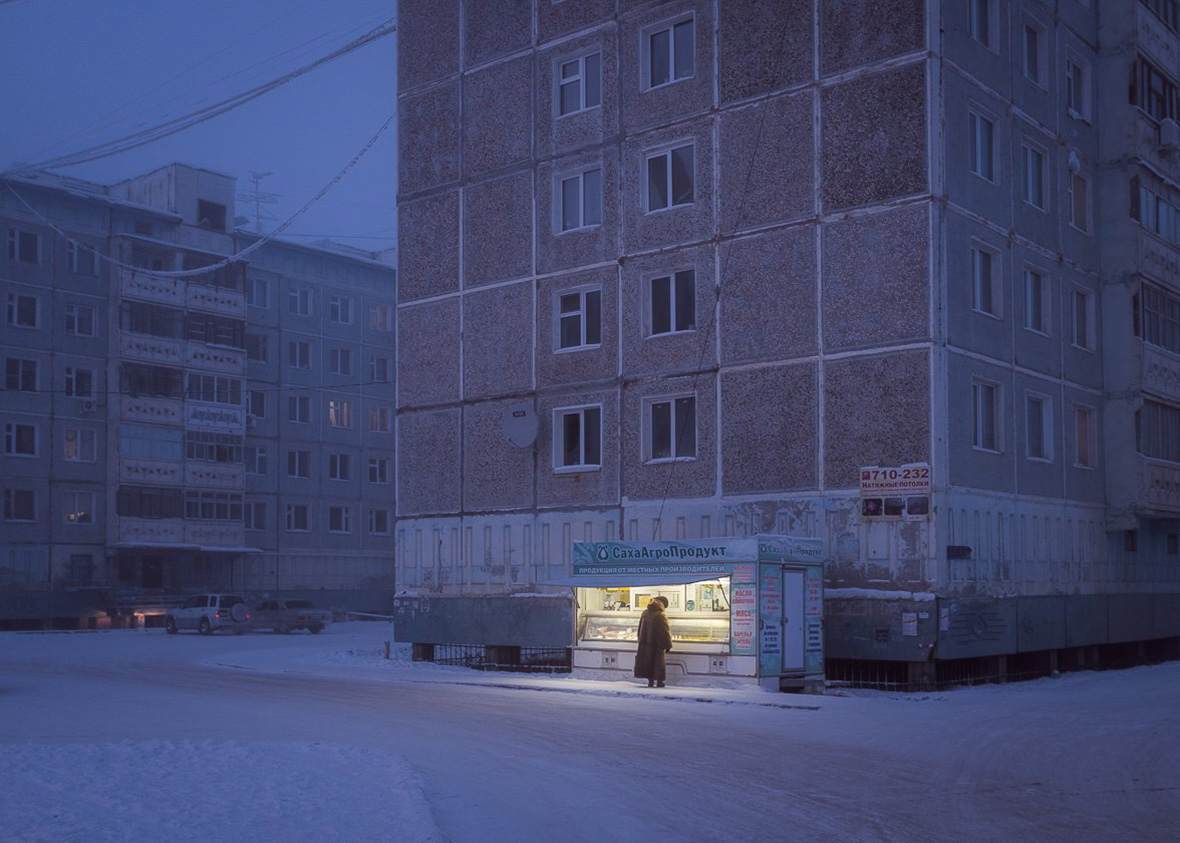
Alexey Vasilyev jokes that living in Yakutia is akin to a curse.
“I thought that maybe all bad photographers end up here when they die,” quips Vasilyev, a renowned Yakutian photographer who’s created a monumental body of work documenting life in the region, a part of Russia’s Siberian Arctic.
Also known as the Sakha Republic, Yakutia is perhaps best known for its frigid climate and vast tundras. Nearly one million people live spread out across the region’s three million square kilometers (one-fifth of Russia’s total territory)—a place equal in size to India, which is home to 1.3 billion. Its capital city Yakutsk is the world’s coldest, where winter temperatures frequently plunge to -40 degrees celsius. In Yakutsk, the buildings stand on stilts to ensure that permafrost, the layers of frozen soil that runs 450 feet deep, don’t melt. Winter fog blooms are also common: the extreme seasonal cold traps hot air from humans, homes, and cars that leave the city streets looking like scenes out of Silent Hill.
Yet Yakutia’s rich cultural legacy, complex history, and intertwined identities reveal a part of the world that’s much more than frozen land.
Alexey Vasilyev 开玩笑说,在雅库特生活就像被诅咒了一样。
“也许所有糟糕的摄影师死后都会来到这里,” 他打趣道。Alexey 在雅库特当地算是位著名的摄影师,他拍摄的大量作品,记录着这个俄罗斯西伯利亚北极圈地区的生活。
雅库特也被称为萨哈共和国,那里极度严寒,拥有广阔的苔原,占地约 300 万平方公里(是俄罗斯国土总面积的五分之一),生活着近 100 万人口;与印度的国土面积旗鼓相当,后者却拥有 13 亿人口。首都雅库茨克是世界上最冷的城市,冬季气温时常在零下 40 摄氏度。在雅库茨克,建筑都要建在高处,以避免 450 英尺深的永冻层融化。与此同时,冬季的大雾天气也时有发生:人类、住宅和汽车产生的热空气困于极端的季节性寒流中,令整座城市看起来就像是《寂静岭》(Silent Hill) 中的场景。
然而,雅库特绝非只是一片遥远的冰雪世界,这里还蕴藏着丰富的文化遗产、错综复杂的历史以及多元的身份。
Epic tales date the Sakha people’s history back to the 10th century, though not much is known about their early history. Yakuts’ modern story begins in the 17th century, in parallel with Imperial Russia’s eastward expansion. By this time, the semi-nomadic Yakuts were already a hybrid community. As Sakha tribes moved throughout northeastern Siberia, they mixed with indigenous groups like the reindeer-herding Evenk, while other evidence points to ancestral ties stemming from Turkic-speaking tribes of the Altai Mountains and Mongol groups in Central Asia.
雅库特人的历史最早可以追溯到 10 世纪,但人们对他们早期的历史知之甚少。雅库特人的现代史开始于 17 世纪,当时正值俄罗斯帝国向东扩张,半游牧的雅库特人已经形成混居的社区:萨哈部落在穿越西伯利亚东北部时,与驯鹿牧民鄂温克人 (Evenk) 等土著群体混居;还有其他证据表明,他们与中亚突厥语系的阿尔泰山部落和蒙古部落也有血缘关系。
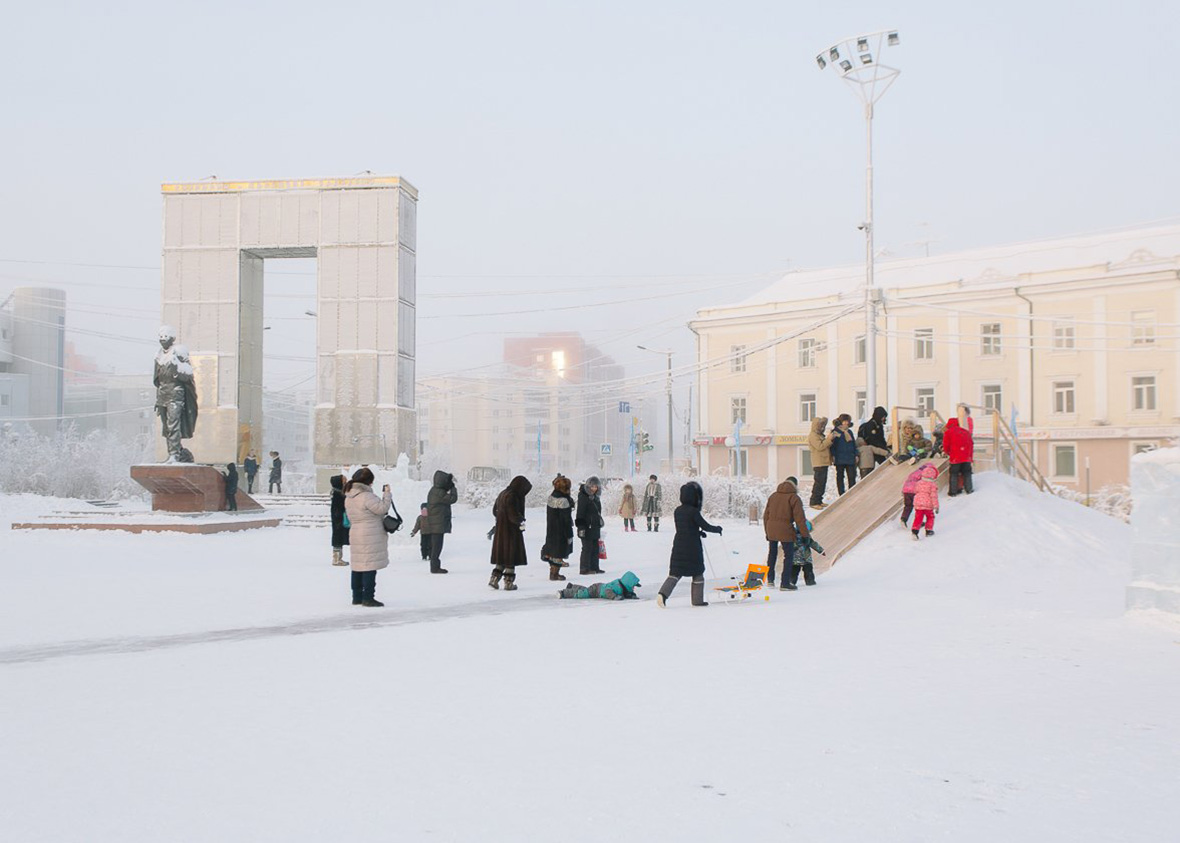
The Sakha Republic now occupies a distinct, and extraordinary, place in Russia—where indigenous Siberian traditions, Asian heritage, and links with Russia and the global Arctic, collide.
The chance to safeguard Yakutia’s story through photography, and to tell this story to a global audience, is what drives Vasilyev’s dedication to photography. Nearly ten years ago, equipped with only his iPhone, Vasilyev first began shooting daily life in Yakutsk as a way to stave off boredom—and manage an on-and-off battle with alcohol. “In my case, alcohol and creativity aren’t compatible,” he says.
如今,雅库特地处俄罗斯一片非凡的区域。在这里,西伯利亚土著传统、与亚洲的血缘联系以及与俄罗斯和全球北极社区的联系全部交融于一体。
通过影像来保护雅库特的历史,并向全球观众讲述它的故事,是促使 Alexey 投身摄影的原因。大概在十年前,Alexey 正处于断断续续的戒酒努力中,因为无聊,他第一次拿起自己的 iPhone 手机开始拍摄雅库茨克的日常生活。“对我来说,酒精和创意是互不相容的,”他说道。
Vasilyev’s commitment to his craft paid off. Global publications like TIME and National Geographic have showcased Vasilyev’s works. And this year, Vasilyev’s Sakhawood series documenting Yakutia’s grassroots film industry won him first place in the category of “Contemporary Issues: Stories” from the World Press Photo—one of the most prestigious prizes in global photojournalism.
“I now understand that I’m not only photographing for myself, but for others,” Vasilyev says. “I’ve begun to believe that I am… a chronicler of Yakutia. I hope my art can help answer the question for Yakuts—who are we and what place do we occupy in the world?”
这些年来,Alexey 对于摄影的投入得到了回报,他的作品被刊登在《时代》和《国家地理》等全球出版物上。今年,Vasilyev 记录雅库特草根电影产业的纪实摄影系列《Sakhawood》为他赢得了著名世界新闻摄影比赛(WPP)“当代热点类:图片故事”的第一名。
Alexey 说:“现在我明白了,我不仅仅是在为自己拍照,也是在为别人拍照。我开始相信,我就是雅库特的记录者。我希望自己的作品能够回答雅库特人心中的疑问:我们是谁?我们在世界处于什么样的位置?”
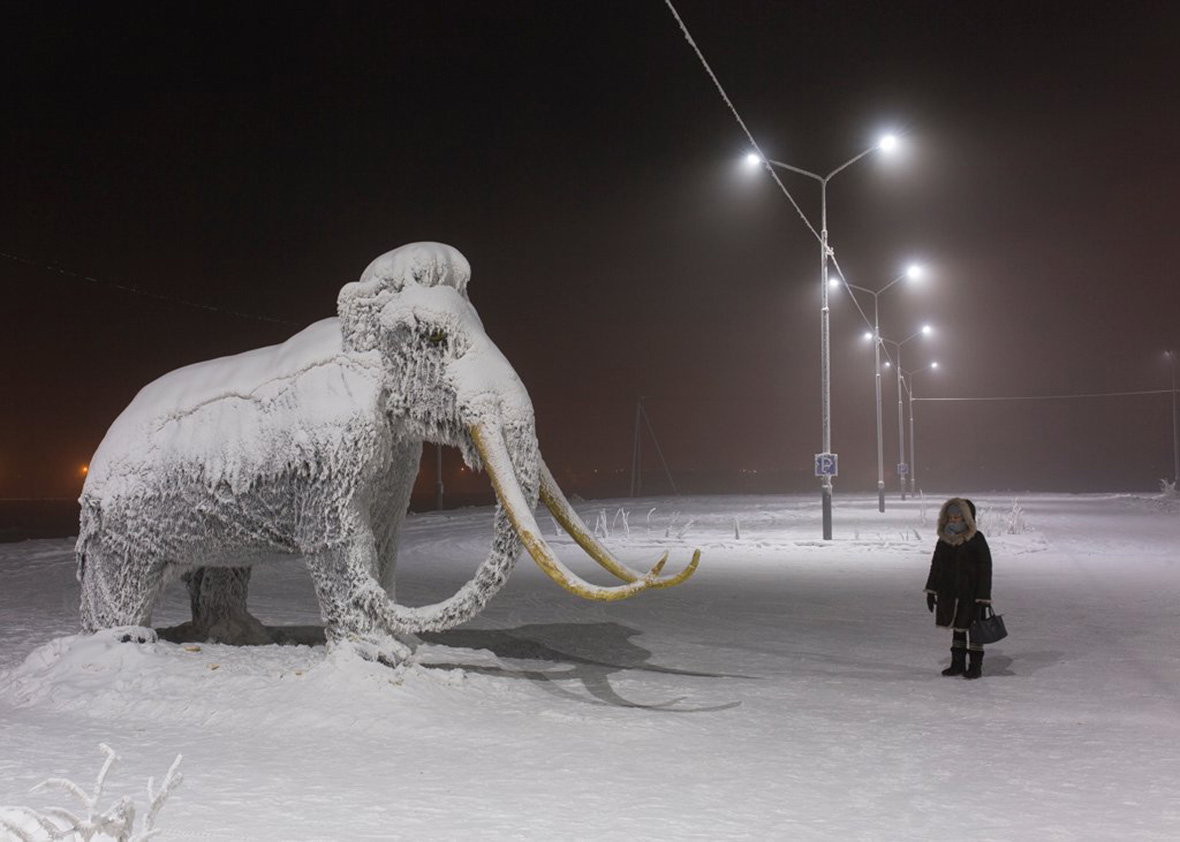
Between Europe and Asia
As a Eurasian nation, Russia’s yearning to be viewed as a “civilized” western nation, largely began with Peter the Great’s westernizing reforms during his reign from 1682 to 1725. But that didn’t stop Imperial Russia’s eastward turn in a bid for more land, resources and power.
Most of Russia’s Asia colonization took place in the 17th century—including the empire’s conquest of the Sakha people and the annexation of territories from a weakened Qing China. In 1632, Russians and Yakuts made their first contact when bands of Cossack soldiers loyal to the Tsarist empire built forts in the Lena Valley, in what was the Yakuts’ heartland. One of these Cossack forts eventually became the settlement of Yakutsk. Imperial Russia then annexed the region.
The empire imposed yasak—a Mongol-Turkic word used to denote a tax established by law (the Mongol empire’s emperor Genghis Khan called his laws the “yasak of Genghis Khan”)—on indigenous peoples in Yakutia like the Yakuts, Evenki, and Chukchi. These groups paid tribute to Tsarist Russia in fur—of sables, foxes, and more, which helped prop up their fur trade.
界于欧亚之间
作为一个欧亚国家,俄罗斯渴望成为西方“文明”国家之列,这种渴望很大程度上始于彼得大帝 (Peter the Great) 在 1682 年至 1725 年统治期间发起的西化改革。但这并没有阻止俄罗斯帝国为了争夺更多土地、资源和权力而向东扩张。
俄罗斯在亚洲的殖民活动大多发生在 17 世纪,包括征服雅库特人以及从没落的清帝国手中吞并领土。1632 年,忠于沙俄的哥萨克士兵在雅库特中心地带的勒拿山谷 (Lena Valley) 修建堡垒,这是俄国人和雅库特人的第一次接触。其中的哥萨克堡垒后来成为了雅库茨克据点,之后又被沙俄吞并。
沙俄对雅库特人、鄂温克人和楚科奇人等雅库特的土著人民征收“yasak”,即蒙古突厥语中的法定税收(蒙古皇帝成吉思汗称他所制定的法律为“成吉思汗的 yasak”),这些部落向沙俄进贡貂皮、狐狸皮等,这进一步促进了他们的毛皮贸易。
Fyodor Dostoevsky, one of Russia’s most loved writers, summed up the country’s long-standing identity crisis in the late 19th century: “Russia is not only in Europe, but also in Asia. The Russian is not only a European, but also an Asiatic” given that two-thirds of the country is geographically in Asia.
The writer proclaimed: “In Europe, we were slaves. But in Asia, we shall be masters. Our civilizing mission in Asia will bribe our spirit and carry us there… a new Russia would be created, which would in time regenerate and resurrect the old one.”
When the Sakha Republic became an autonomous republic of the Soviet Union in 1922, the region was already indelibly intertwined with Russian social, cultural, and religious norms.
Sakha’s incorporation and assimilation into Russia is something Yakuts accept “as history—as a given. It’s something we can’t change now,” says Vasilyev. The photographer identifies as an Asian and a Yakut in Yakutia—a place which is an indelible part of Russia, he explains. “Growing up in the 1990s, I only learned Russian. My main language—in which I think, read, understand, speak and love—is Russian. But now, I believe it’s very important to know our national language, too.”
俄罗斯著名作家之一陀思妥耶夫斯基 (Fyodor Dostoevsky) 在 19 世纪末曾指出这个国家长期存在的身份危机:“俄罗斯不仅在欧洲,也在亚洲。俄罗斯人不仅是欧洲人,也是亚洲的一部分”,甚至有三分之二的土地都位于亚洲。
他写道:“在欧洲,我们曾经是奴隶。但在亚洲,我们将成为主人。我们在亚洲的文明使命将激励着我们前进……一个新的俄罗斯将诞生,假以时日,它将能让旧的俄罗斯重生和复兴。”
1922 年,当雅库特共和国成为苏联的自治共和国时,这个地区已经与俄罗斯的社会、文化和宗教规范不可分割地交织在一起。
雅库特人接受了自己的一部分被俄罗斯同化,正如 Alexey 所说“这是历史必然。是我们现在无法改变的事实。”他自视为亚洲人和雅库特人,而雅库特却又是俄罗斯不可或缺的一部分。“我成长于上世纪九十年代,打小只学过俄语。一直以来,我所运用的语言,我的思考方式、阅读、理解、交流工具,自始至终都是俄语。但现在我渐渐明白,了解属于雅库特人自己的语言,是生活中十分重要的事。”
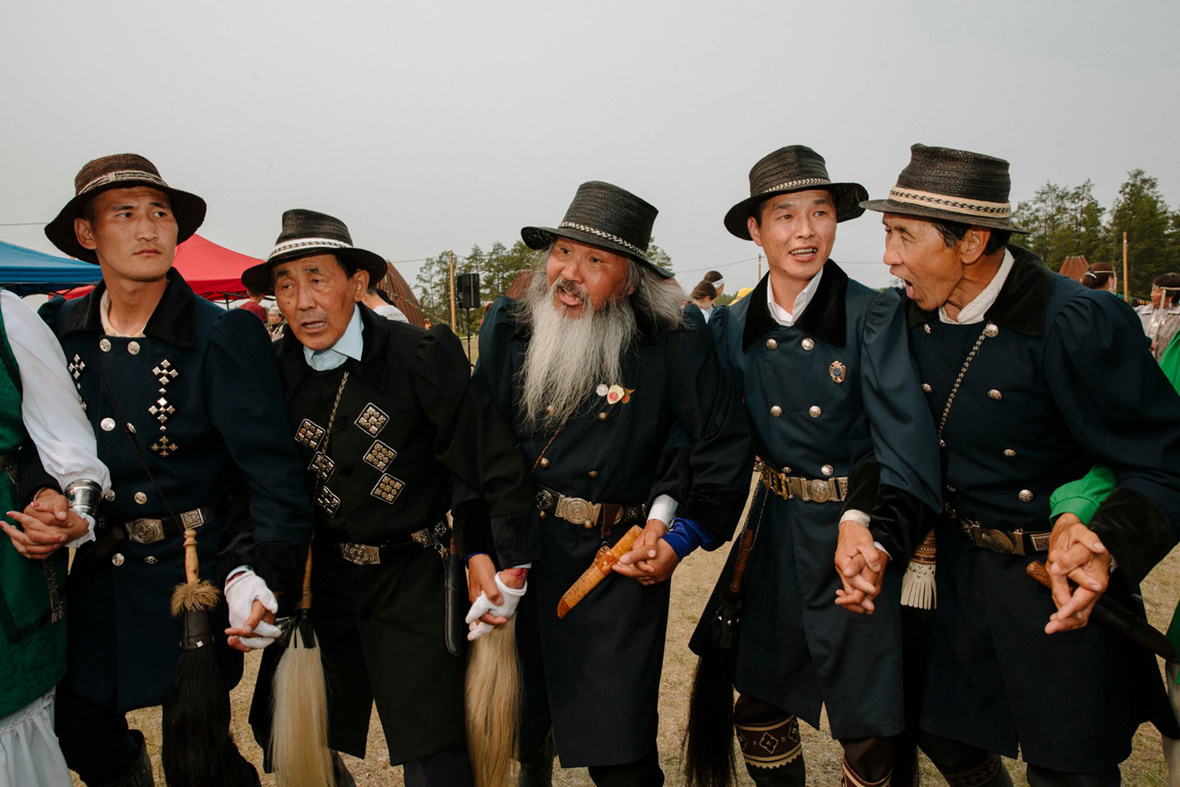
Sakha spirit
Yakutia’s deep entanglement with Russia is undeniable. Yet, rituals and beliefs unique to Sakha culture have not only survived, but have experienced a newfound renaissance in recent years.
Vasilyev captures the Sakha spirit through his photo series Ysyakh—a tribute to Yakutia’s New Year, the region’s most-loved holiday. During the summer solstice in June, Yakuts come together to thank the Sakha deities for the upcoming year through food, dance, sport, and other festivities. Ysyakh, which originated around 2,000 years ago, is a blend of shamanic, indigenous, and Mongolian traditions. It’s a fundamental part of Yakutia’s cultural heritage and “important part of our national identity — a moment when we become an organic whole,” Vasilyev wrote in The Guardian.
During Ysyakh, the white shaman—whom Yakuts believe to have a close connection with the spiritual realm—leads festival processions, performing blessings, ceremonial dances, and singing prayers. The white shaman gives the traditional offerings of pancakes and kumi (fermented horse milk) to the gods. The central role of kumi may have been passed down from Mongolian traditions; in the thirteenth and fourteenth centuries for instance, the fermented milk was also used in new year rituals to ensure the health of the herds and Genghis Khan.
Finally, at dawn, Yakuts turn toward the sky to catch the first summer rays with their outstretched palms; and pray for happiness and fortune.
That such traditions take place in Yakutia today is almost miraculous. Orthodox priests undertook efforts to Christianize the Sakha people during the Imperial era, with mixed results. In the Soviet era, Yakutia became a hotspot for gulags—Soviet concentration camps—due to the region’s natural resource abundance alongside its geographic isolation. Soviet authorities also sought to starve indigenous traditions, and the Ysyakh holiday was secularized and Sovietized. Communicating with Sakha spirits was forbidden; instead, people were encouraged to give thanks and offerings to portraits of Stalin, instead.
萨哈神灵
毋庸置疑,雅库特与俄罗斯之间有着千丝万缕的联系。然而,萨哈文化所独有的仪式和信仰不仅得以流传下来,并在最近几年经历了新一轮的复兴。
Alexey 在自己的摄影系列《Ysyakh》(恩萨赫节)中便展示了萨哈文化。恩萨赫节(Ysyakh)是雅库特人的传统新年,是当地人最喜欢的节日。在 6 月的夏至期间,雅库特人聚集在一起,通过食物、舞蹈、运动和其他庆祝活动,为即将到来的一年感谢萨哈神灵。恩萨赫节起源于大约 2000 年前,是萨满教、土著文化和蒙古传统交融的成果。Alexey 在《卫报》的文章中表示,这是雅库特文化传承的重要部分,也是“我们民族身份的重要组成部分,是我们凝聚在一起的时刻”。
节日期间,身穿白衣的萨满祭司带着大伙儿们游行、祈祷,舞蹈和歌唱。雅库特人认为,萨满祭司是和灵界有着密切联系的人。白衣萨满祭司将传统煎饼和“kumi”(酸马奶)等祭品供奉给神。以酸马奶作为重要祭品可能是受蒙古传统的影响,在 13 和 14 世纪,酸奶也被用于新年仪式,以祈祷保佑畜群和成吉思汗健康。
黎明时分,雅库特人一齐望向天空,伸出手掌,捕捉夏天的第一缕阳光,祈祷幸福和好运。
时至今日,仍然能在雅库特看到这样的传统仪式实属罕见。沙俄时代,东正教牧师致力将雅库特人基督教化,结果好坏参半。在苏联时代,因为雅库特当地的富饶的自然资源和地理上的孤立,古拉格(苏联劳动改造营)在这里安营扎寨。苏联当局还试图淡化土著传统,将恩萨赫节日世俗化、苏维埃化。禁止人们与萨哈神灵交流;同时鼓励人们对斯大林画像的感恩与崇拜。
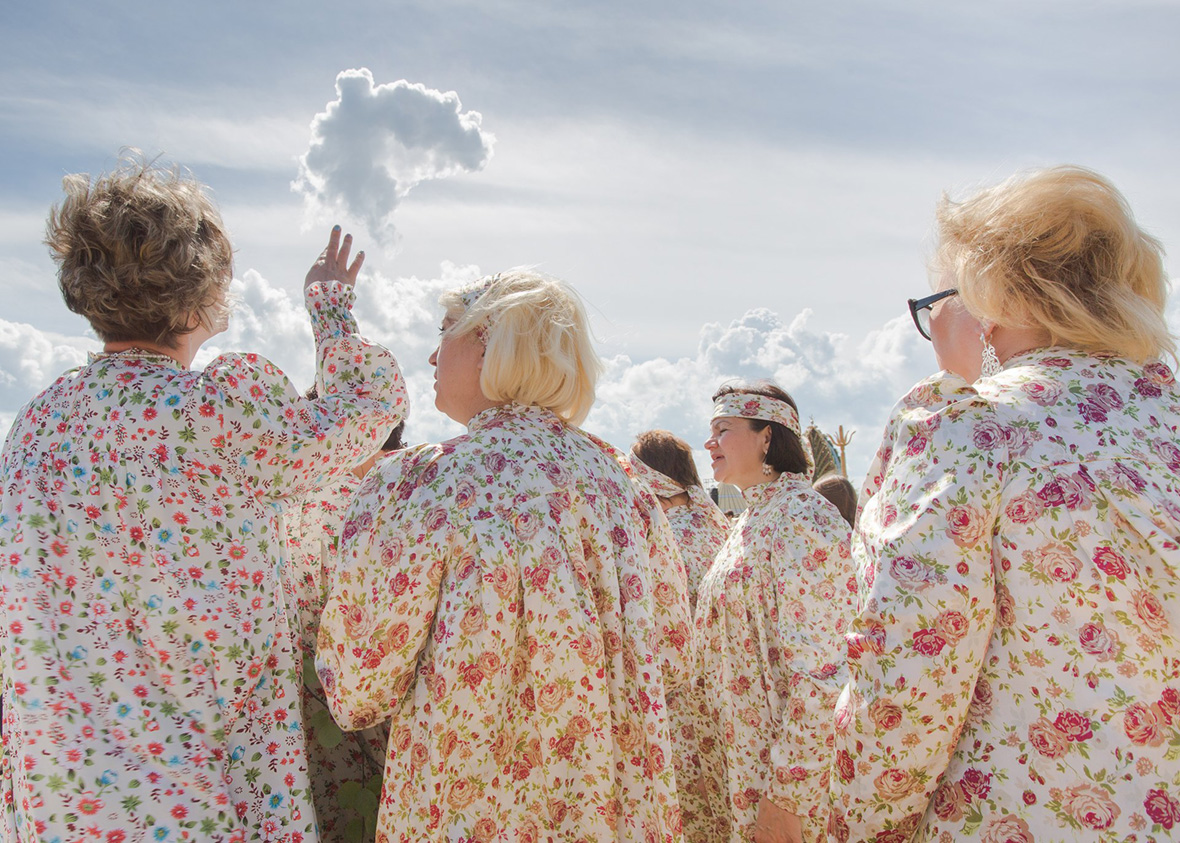
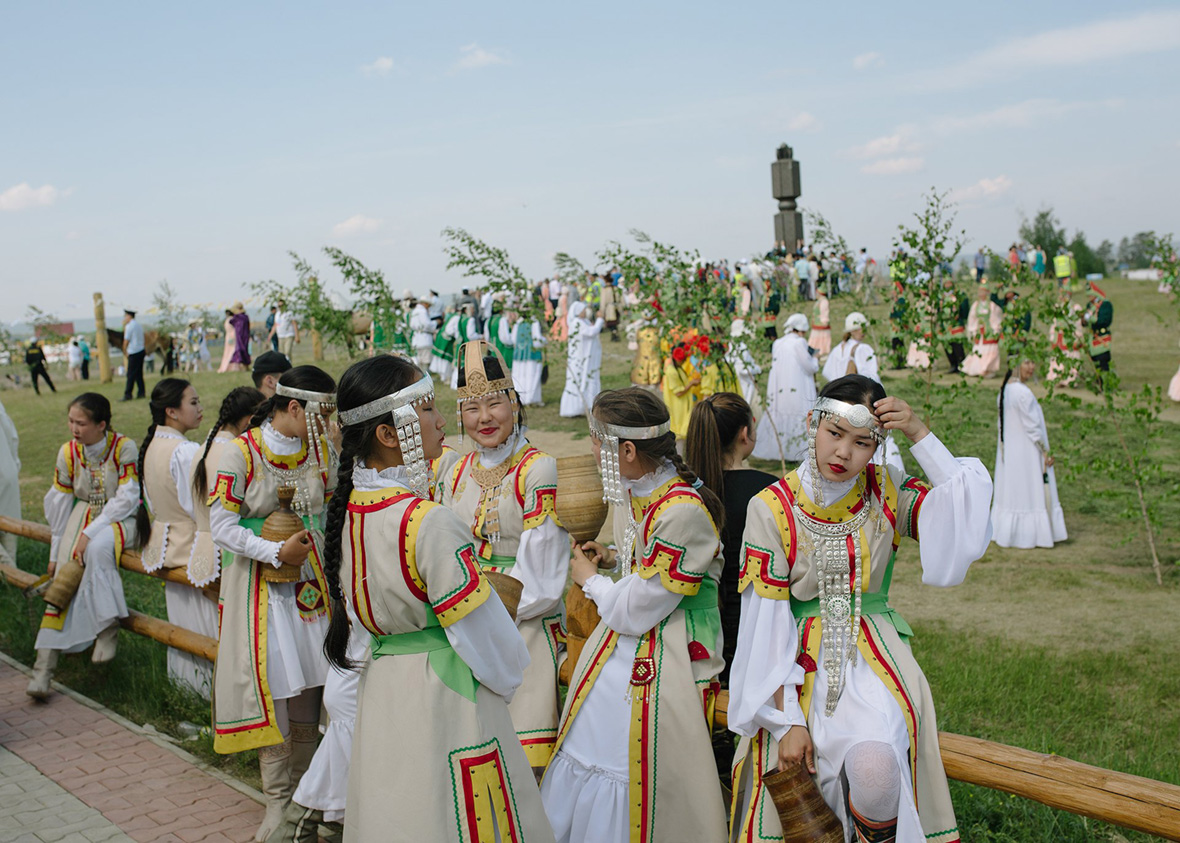
By the late 1980’s, Yakutia’s intellectual and artistic communities instigated a revival of Sakha heritage, which paved the way for Ysyakh to find its way back to its true meaning. In 1992, the first administration of the New Republic of Sakha, a non-Soviet government, designated Ysyakh a formal state holiday.
In Vasilyev’s documentation of the festival, Yakutia is transformed into an ethereal place, far from its somber moments of history, or winter reality of dense fog and whistling snow. “[Our] brand is usually winter, but I wanted to show summer,” he says. Vasilyev also acknowledges that there are “dark sides of our life [in Yakutia], but I don’t want to show it.” The photographer references the alcohol addiction in the region and in Russia, at large: “It seems to me that in our country, alcohol doesn’t let people relax and have fun, but leads to overconsumption and aggression. [But] I can’t solve these problems with photography but only hurt someone’s feelings. Sure, I want to show truths that may be harsh, but at the same time leave room for inspiration and some kind of light sadness.”
His take on Ysyakh is akin to a soft, pastel dream sequence in which cream-colored horses roam green steppes under powder-blue skies; where families, dressed in their best, reunite under the summer sun to pray to the gods.
Yakut and Russian women are clad in floor-length, floral khaladaai dresses; while young girls wear bastinga headdresses and are decked out in ornamental silver jewelry laughing over ice cream and waiting for their turn to dance. Others wear white robes and matching headscarves while burning incense to purify the grounds of negative energy.
到 20 世纪 80 年代末,雅库特知识分子和艺术团体发起了复兴萨哈传统的运动,实现了恢复恩萨赫节的真正意义。1992 年,非苏维埃政府的萨哈新共和国第一届政府将恩萨赫节定为正式的国家节日。
在 Alexey 关于这个节日的纪实摄影作品中,雅库特变成一片空灵之地,毫无灰暗历史的痕迹,也没有冬日浓雾和呼啸。他解释说:“严寒的冬季是这里的特色,而我希望展示的却是夏季。”与此同时,他承认:“(雅库特的)生活也有自己的黑暗一面,但我不愿展示。”这位摄影师所指的是该地区和俄罗斯普遍存在的酗酒问题,“在我看来,在我们国家,酒精并不能让人们放松和消遣,反而会导致人们酗酒成风,变得有攻击性。摄影无法解决这些问题,只会伤害一些人的感情。当然,我也希望捕捉事实,但同时我更想带给人们鼓舞的情绪,凝结在其中的伤感让观众慢慢体会。”
他所拍摄的恩萨赫节是柔美且梦幻的景象——淡蓝色的晴空之下,奶白色的马匹徜徉在绿油的草原之上;人们盛装打扮,和家人沐浴阳光,他们欢聚,彼此祝福。
雅库特和俄罗斯妇女穿着拖地的碎花 khaladaai 长裙;年轻的女孩戴着 bastinga 头饰和华丽的银首饰,一边说笑,一边享用手中的冰淇淋,她们正在等待即将上台的跳舞表演。还有的人穿着白袍和白色的头巾,他们烧香礼拜,祈祷尘世间的负面能够得到净化。
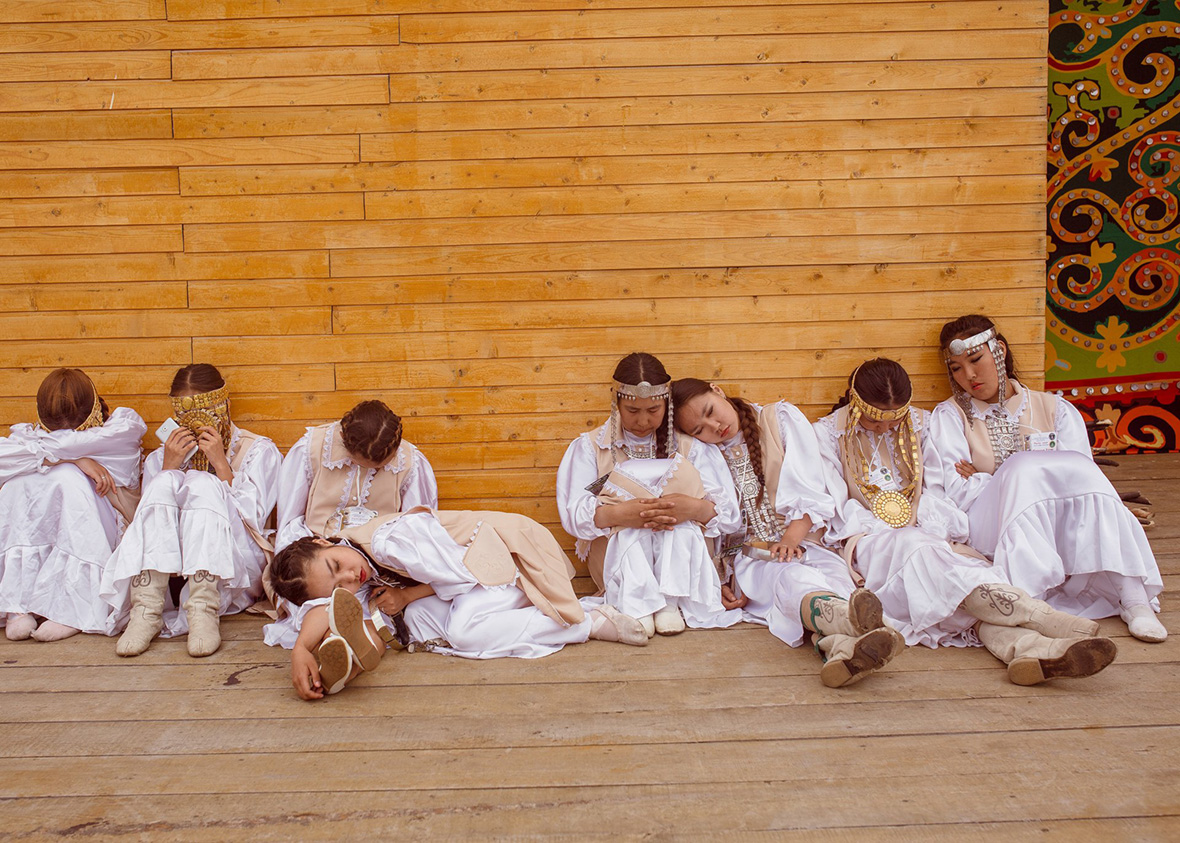
Reverent Nature
When Vasilyev’s grandmother was dying of cancer, he cooked pancakes—a traditional Sakha and Russian food—for the first time in his life. The pancakes were an offering for Yakutia’s nature gods. “I went to the river and started asking for spirits. I didn’t even know which ones to ask for… but I asked them to somehow alleviate her suffering.”
For Sakha people, nature is animate and teeming with powerful spirits who play a potent force in human life. The nature spirits are worthy of awe, reverence, and even fear. “We live in harsh natural conditions and are used to relying on ourselves,” says Vasilyev. “But before any important, or even insignificant event, in our lives, we have to appease the fire, earth, and water spirits. Sometimes we appease them so that we get lucky.”
Yakutia’s local film industry, known as “Sakhawood,” deftly captures Sakha’s natural mysticism tied up with modern life. Sakhawood sprung up in the early 1990s as a way for Yakuts to reclaim their narrative. “Our culture was destroyed [after] 70 years of Soviet rule. Shamanism, our traditional faith, and other customs were banned. But now we’re bringing them back,” said Aleksei Romanov, a renowned Yakut director who founded Sakhafilm, Yakutia’s premier film studio, in 1992.
敬畏自然
那年 Alexey 祖母因癌症病危时,他生平第一次做了煎饼——这是一种传统的雅库特食物。人们认为,煎饼是献给雅库特大自然神灵的祭品。“我在河边祈求神灵,祈求他们能减轻祖母的痛楚。”
对雅库特人来说,大自然充满生机,住着各路能通广大的神灵,他们在人类栖息的世界里担任重要的职责。因此,大自然是值得尊敬、崇拜,甚至是敬畏的。Vasilyev 说:“雅库特人生活环境恶劣,早已习惯自食其力。但在我们生命中,无论如何,都必须要告慰火、土、水之灵。人们相信这样做能为自己带来好运。”
雅库特当地的电影产业被称为“Sakhawood”,这个词巧妙地结合了萨哈的自然神秘主义与现代生活。Sakhawood 兴起于 20 世纪 90 年代初,是了解雅库特故事的绝佳途径。雅库特著名导演 Aleksei Romanov 说:“苏联统治的 70 年后,我们的文化遭到了严重打击。传统和信仰被抛弃。现在,我们要把过去重新拾起。”1992 年,Aleksei 成立了雅库特第一家电影制片厂萨哈电影 (Sakhafilm)。
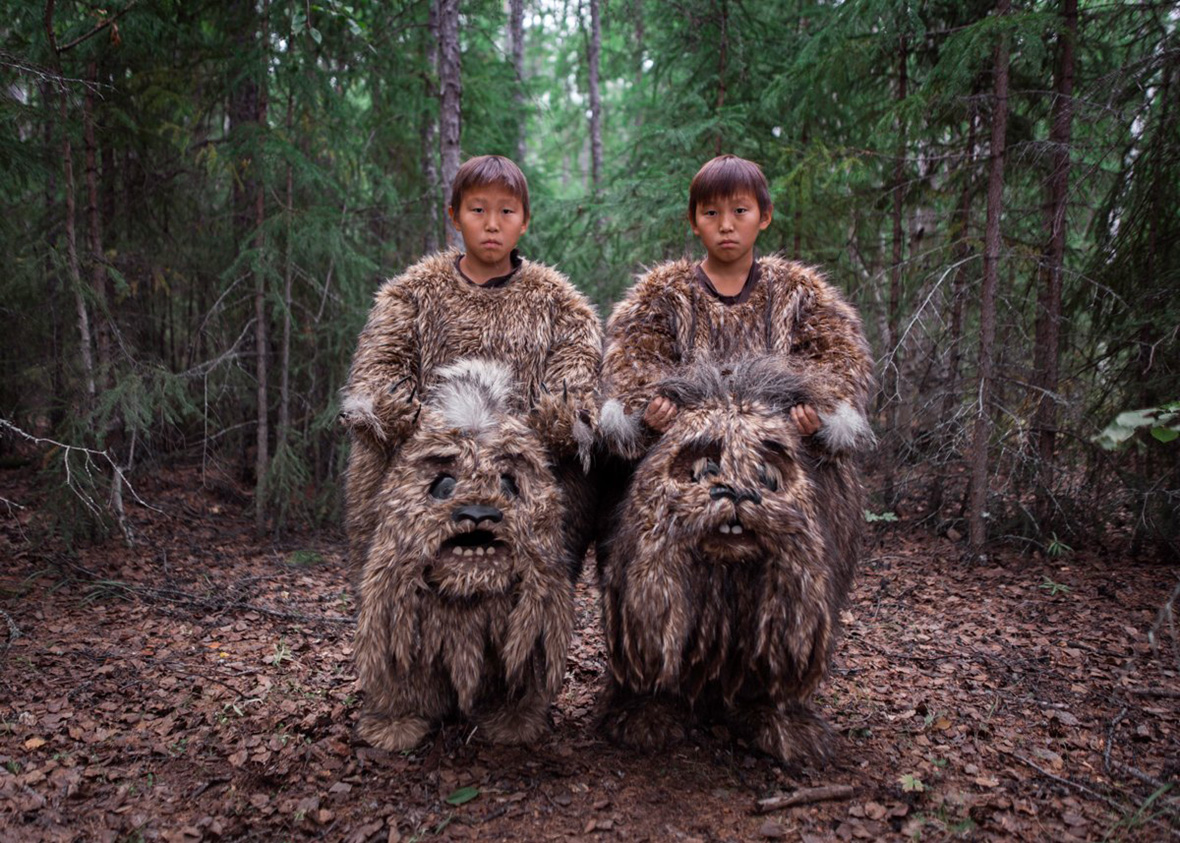
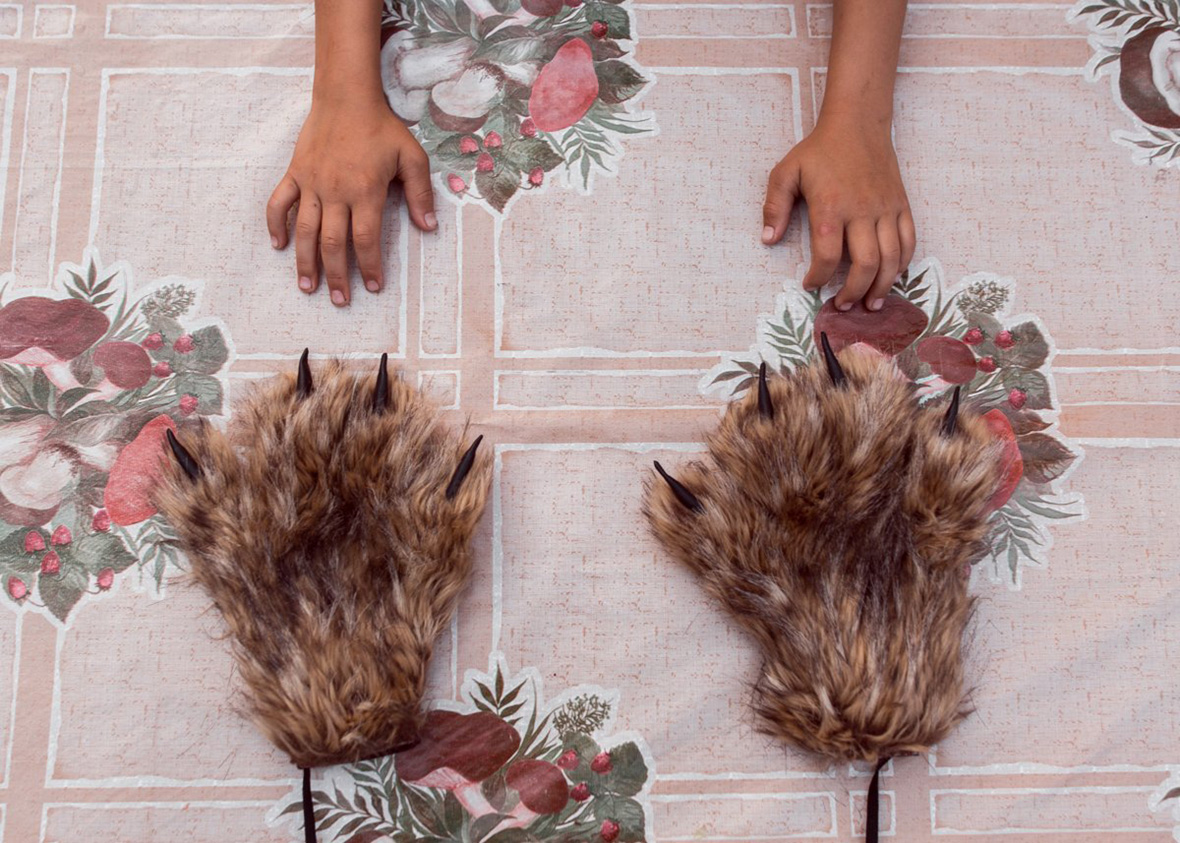
And Sakhawood films have begun to garner international acclaim, with its movies shown at film festivals from Seoul to Frankfurt. For the past few years, Vasilyev became a fly-on-the-wall at Sakhawood productions. His eponymous photo series documents this burgeoning local film industry as they recreate Yakutia’s modern-day human dramas intertwined with the fantastical and mystical revered in traditional Sakha culture.
In one of the most-recognized works from Vasilyev’s ‘Sakhawood,’ two young twin brothers Semyon and Stepan, stand in a dim forest clearing covered with leaves dressed in a furry, Ewok-like costume for their film debut. The twins were cast in the role of ‘dulgancha,’ the mythical swamp creature of Yakutia’s imagination in a scene from The Old Beyberikeen and the Five Cows, a hit 2019 film based on a classic Sakha fairytale.
Another of Vasilyev’s shots from the film shows the leading character — clad in a fur vest and armed with a homemade dagger — battling an abaasy, the Sakha spirit of the underworld, outside of an earthly, misty forest. Traditional Sakha lore says that three realms exist: the heavens, the middle world populated with humans, and a lower realm where evil spirits reside.
In the folktale about the old beyberikeen’(the old lady), her wish for a daughter is granted when a beautiful, young girl blossoms out of a fast-growing sprout she plucked from her garden. But the girl eventually falls prey to the devil’s daughter, who “tore off all the girl’s skin and put it on her face.” The prince, who was to wed the old lady’s daughter, eventually has to battle evil forces to revive his true bride and restore harmony to the land.
“If you look at Sakhawood, you can feel our reverence for nature. You can see the relationship between the power of nature, its mystical aspects, and its role in human life,” says Vasilyev.
这些年来,Sakhawood 电影逐渐开始获得国际上的关注,在首尔和法兰克福等电影节纷纷亮相。Alexey 是 Sakhawood 电影制作行业的一位冷静观察者,他创作了同名摄影系列,记录了当地蓬勃发展的电影产业,交织着奇异和神秘的传统萨哈文化片段。
《Sakhawood》系列有一张很特别的照片:年轻的双胞胎兄弟 Semyon 和 Stepan 伫立在满是落叶的森林空地上,穿着毛茸的伊沃克(Ewok,《星球大战》中长毛皮的智慧两足动物)式服装。他们正在饰演的是电影《老贝伊伯利克恩和五头牛》(The Old Beyberikeen and the Five Cows)中的雅库特神秘沼泽生物。这部上映于 2019 年的电影根据萨哈经典童话改编,在当地大热。
在关于这部电影的另一幅照片中,主角身披毛皮背心,手持自制匕首,在迷雾笼罩的森林外与来自地下世界的萨哈神灵“abaasy”决一死战。据传说,萨哈存在三个世界,分别是天堂、人类居住的中间世界和恶灵居住的地界。
在关于“beyberikeen”(意为老太太)的民间故事中,这位老太太想要一个女儿的愿望得到了实现——她在花园拔下快速生长的嫩芽,化作可爱的姑娘。不过,女孩最终沦为魔鬼的牺牲品,魔鬼“剥下女孩的皮肤,横挂在自己脸上”。原本要娶女孩为妻的王子,不得不与邪恶势力斗争,以复活他真正的新娘,并恢复世间的安宁。
“观看 Sakhawood 电影时,你可以感受到我们对大自然的那份敬畏、能感受大自然的力量、自然与人之间的关系、以及它神秘的一面。”
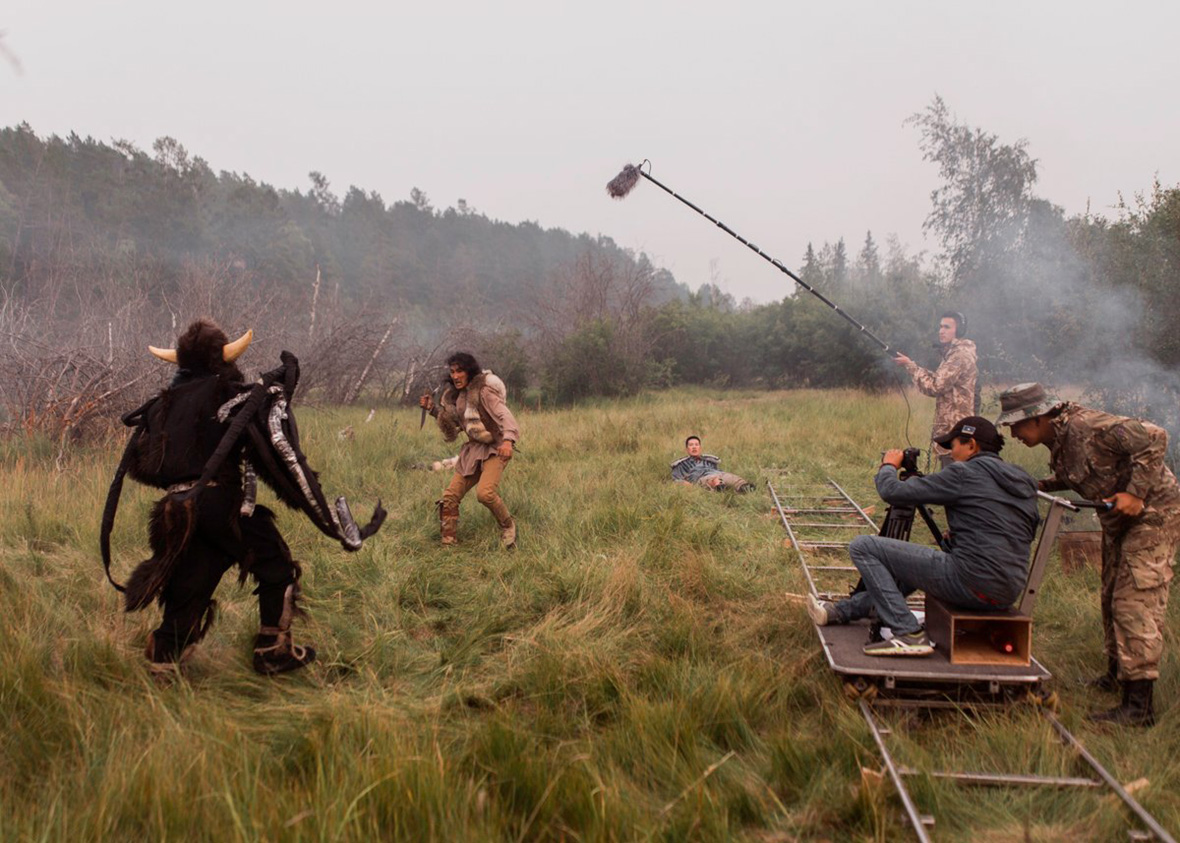
Myths and rituals are prominent in today’s Yakutia, but they exist alongside modern life and within Russian cultural institutions, as well. In Black Snow (also known as Khara Khaar), a film by renowned Yakutian director Stepan Burnashev, Vasilyev captures three actors playing truck drivers, smoking, and looking over their script in a dilapidated Russian log cabin. The film is a drama about the mundanity and petty human longings— for money, ego—that take place in Sakha, like everywhere else in the world. It won Best Feature at the Window to Europe Film Festival last year.
For his behind-the-scenes shots, Sakhawood won a top prize at the World Photo Press 2021 Photo Contest.
While Vasilyev doesn’t dwell on his successes, he acknowledges that with growing recognition comes a greater sense of responsibility.
“Life is [the same] as it was five years ago. A typical day could mean intensive shooting or a whole day spent watching documentaries. I’m still a simple person with all my weaknesses. I meet with my small circle of friends. We go to the movies, read the news and surf social networks. I have a girlfriend and I enjoy my time with her,” he says.
And last year—the first year of the pandemic—the renowned photographer even worked as a courier as businesses were disrupted worldwide. “I delivered goods, came home, and watched TV. The pandemic was shit! I practically didn’t shoot anything and had to earn money another way.”
Sometimes Vasilyev wonders if any catastrophic events were to happen in Yakutia, would “anyone find out about it — or even care? If Yakutian culture were to disappear altogether, would it somehow affect the world?” The fact that his images are lauded worldwide means that “the more people know about Yakutia, the louder our voice will be in the world,” Vasilyev says.
神话和宗教仪式在今天的雅库特中依然重要,它们与现代生活共存。由雅库特著名导演 Stepan Burnashev 执导的电影《黑雪》(Khara Khaar),讲述了当代雅库特人于世俗间的渺小渴望——金钱和自我,这个当代社会不变的话题。电影最终在去年的欧洲之窗电影节 (Window to Europe Film Festival) 上,获得了最佳剧情片大奖。同时,作为电影的幕后摄影师,《Sakhawood》获得了 2021 年世界新闻摄影比赛第一名。
在巨大的成功面前,Alexey 却十分清醒。他坦承,随着越来越多人认识他,而他肩负的责任也变得越来越大。“我现在的生活和五年前没什么不一样。每天还是在密集地拍摄或者花一整天的时间看纪录片。我仍然是一个简单的人,也有着各种的缺点。我有我的小圈子,也会和几位朋友见见面,一起去看电影、聊聊身边琐事。我有女朋友了,我很享受和她在一起的时光。”
在去年,也就是疫情爆发的第一年,这位著名的摄影师甚至还当过一阵子快递员。“疫情太糟糕了,我每天除了送货,然后就是回家看电视!因为当时全球经济几乎停摆,我没有拍过任何东西,只能通过另一种方式养活自己。”
疫情期间, Alexey 会想,假如某一天,雅库特突然遭遇灾难性事件,“会有人发现吗?甚至会有人关心吗?如果雅库特文化彻底消失,会对世界有任何的影响吗?”Alexey 表示,自己的作品能在世界各地受到肯定,这意味着“人们对雅库特是感兴趣的,只要一直把摄影坚持下去,我们在世界上的声音就会越大。”

My Dear Yakutia
Today, a reckoning is taking place in Yakutia. “There’s a feeling that we are Yakuts and we must preserve and respect our culture,” Vasilyev says. “This feeling is growing. It’s manifesting itself in national politics and in popular culture, like music and film. Our younger generations are starting to feel a stronger attachment to this identity and care more about this culture.”
Before he began photographing on his own, Vasilyev was a photographer for local paper Youth of the North, where he often took portraits of children in the city. For nearly a decade, he attended kids checkers’ tournaments, ballet performances, and wrestling matches; Yakutian and Russian kids coexisted alongside both Yakut and Russian culture and institutions.
But he began to notice what he describes as Russia’s ‘national chauvinism.’ “Living in Russia, we feel like strangers. I want to show that not only [Slavic] Russians live in Russia,” explaining that it seems as though the country is indifferent to the 120 different ethnic groups in Russia.
亲爱的雅库特
今天的雅库特正在进行一场觉醒。Alexey 说:“整个社会开始凝聚起来,我们是雅库特人,我们必须保护和尊重我们的文化。这种氛围越来越强烈。这体现在国家政治和流行文化中,比如音乐和电影。我们年轻一代开始对这种身份产生更强烈的依恋,更关心传统。”
在 Alexey 成为一名独立摄影师之前,曾是当地报纸《北方青年》(Youth of the North) 的一名儿童摄影师。在近十年的时间里,他参加了各种儿童跳棋比赛、芭蕾舞表演和摔跤比赛;亲眼目睹了这些孩子在雅库特和俄罗斯共存的文化体制中成长。
他开始留意到俄罗斯社会有一种“民族沙文主义”。“生活在俄罗斯,我们感觉像局外人。真正的斯拉夫人 (Slavic) 并不认为雅库特属于他们。”Alexey 觉得,俄罗斯似乎对生活在这里的 120 个不同民族漠不关心。
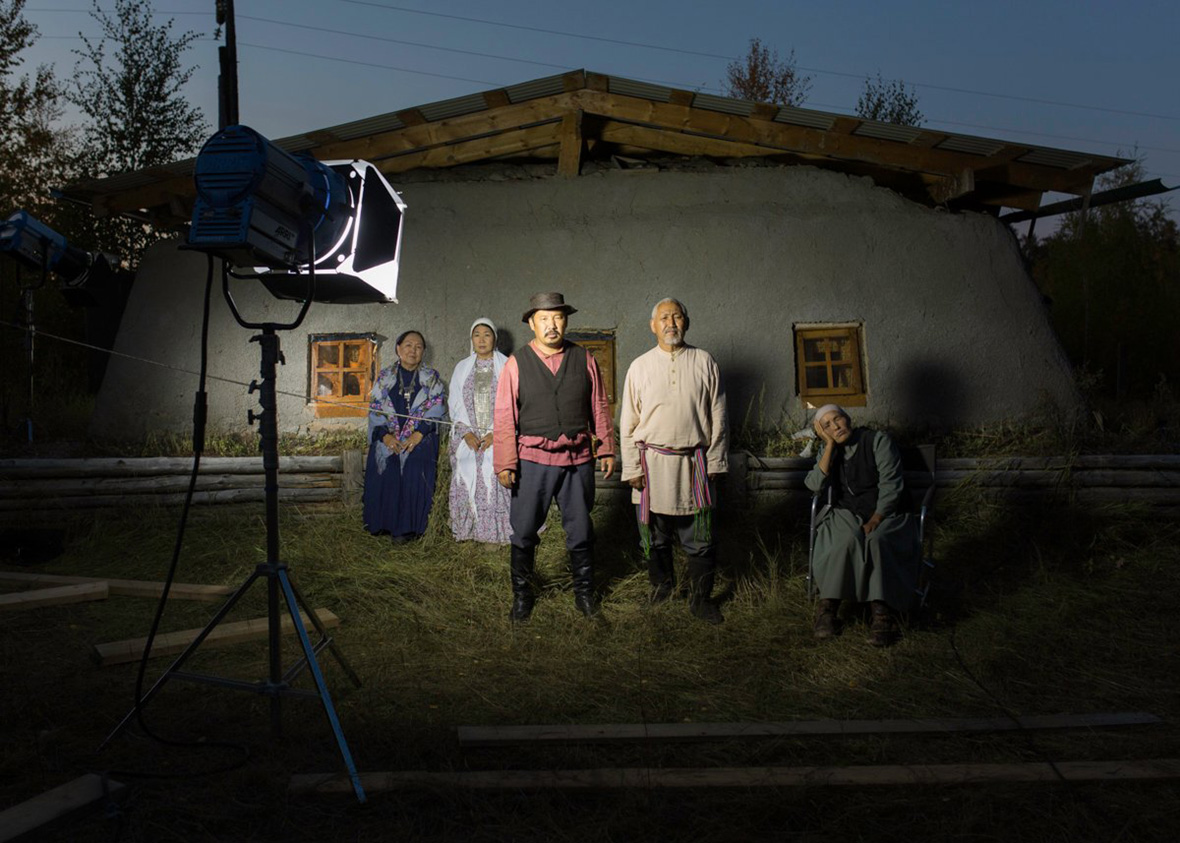
Thus, the photographer’s current, yet-to-be-released project is an even deeper look at the region. Vasilyev’s new focus is on Sakha’s various indigenous peoples of the north—“Evenks, Yukagirs, Chukchi and Dolgans. I want to make a project about their lives. We’ve lived with them for almost several centuries.” While Yakuts are the majority in Sakha yet a minority in Russia; the smaller indigenous groups which make up less than 1% of the population in the region, are mixed and contributed much. Northern Yakuts for instance, adopted the practice of reindeer breeding from Evenk groups.
And beyond the cultural reckoning, another one is taking place related to Sakha’s natural environment. Yakutia, like other parts of Siberia, are bearing the brunt of climate change. This summer—Yakutia’s hottest and driest on record—93 active wildfires have burned through 1.1 million hectares of land, making Sakha the worst wildfire-affected region of Russia. Vasilyev’s recent works show forest officers and volunteer firefighters battling raging blazes and thick smoke across the region’s charred forests. “We must protect our nature. Our permafrost is melting; people are suffering; and Siberia has been burning for many years. But nobody cares about this catastrophe,” he says.
Through his art, Vasilyev ultimately wants the world “to know about us… and to see that we’re all interconnected.”
于是,在他目前尚未发布的新项目中,他对这个地区进行了更深入的观察,这一次,他的关注点是萨哈北部的各种土著民族,“比如鄂温克人、Yukagirs、楚科奇人和 Dolgans,我们和他们一起生活了近几个世纪。所以我想拍摄一个关于他们的系列。”虽然雅库特人在当地占多数,但放在整个俄罗斯,却依然只是少数民族;而占该地区人口不到 1% 少数土著群体相互之间交融很深,且对社会也有着很大的贡献。例如,北方雅库特人就曾学习鄂温克部落繁育驯鹿的做法。
除了文化上的觉醒,萨哈的自然环境也在经历变化。雅库特和西伯利亚的其他地区一样,首当其冲地受到气候变化的影响。今年夏天,雅库特经历了有记录以来最热、最干燥的天气,93 场野火烧毁了 110 万公顷的土地,使雅库特成为俄罗斯受灾影响最严重的地区。Alexey 最近的作品展示了森林工作人员和志愿消防员在当地森林中与熊熊大火斗争的画面。他说:“我们必须保护大自然。永冻层正在融化,人类正在自食其果;现在,每年西伯利亚都有大火,但似乎没人在乎这场灾难。” Alexey 希望通过自己的作品,让人们了解这个世界上最寒冷的国度,以及万物之间的联系。
Like our stories? Follow us on Facebook and Instagram.
Website: www.alexey-vasilyev.com
Instagram: @lekon_v
Contributor: Yvonne Lau
Chinese Translation: Olivia Li

